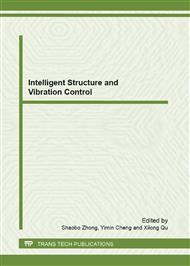[1]
XuYanhai. Computer simulation on stochastic road rregularities[J]. Transactions of the Chinese Society for Agricultural Machinery, Vol. 38(1)(2007), pp.33-36.
Google Scholar
[2]
Zhang Yonglin. Research on time series modeling method of 3D stochastic road[J]. Journal of Wuhan University of Technology, Vol. 29(8) (2007), pp.92-95.
Google Scholar
[3]
Zhang Jiafan. Numerical simulation of stochastic road process using white noise filtration[J]. Mechanical Systems and Signal Processing, Vol. 20(2) (2006), pp.363-372.
DOI: 10.1016/j.ymssp.2005.01.009
Google Scholar
[4]
Yoshimura A. Semi-active suspension of passenger cars using fussy reasoning and the field testing[J]. Int.J. of Vehicle Designs, Vol. 19(2) (1998), pp.150-166.
Google Scholar
[5]
Zhang Yonglin. Time domain model of road irregularities simulated using the harmony superposition method[J]. Transactions of the Chinese Society of Agricultural Engineering, Vol. 19(6) (2003), pp.32-35.
Google Scholar
[6]
Jiang Li-biao, Wang Deng-feng, Xie Dong et al. Buildup and simulation of a truck model with rear air suspension using leaf spring as guiding rod[J]. Journal of Harbin Institute of Technology(new series), Vol. 13(6) (2006), pp.654-657.
Google Scholar
[7]
Lin Jiahao, Williams F W. Computation and analysis of multi-excitation random seismic responses [J]Engineering Computations, Vol. 9(5) (1992), pp.561-574.
DOI: 10.1108/eb023884
Google Scholar
[8]
Carassale L, Tubino F, Solari G. Seismic response of multi-sup-ported structures by proper orthogonal decomposition. Proceed-ings of International Conference on Advances in Structural Dynamics (ASD2000), Hong Kong. Elsevier Science Ltd, (2000).
DOI: 10.1002/eqe.292
Google Scholar
[9]
Wang ML, Heo G, Satpathi D. Dynamic characterization of a long span bridge: a finite element based approach. Soil Dynam Earthq Eng, Vol. 16(7-8)(1997), pp.503-12.
DOI: 10.1016/s0267-7261(97)00009-2
Google Scholar
[10]
Xue SD, Cao Z, Wang XS. Random vibration study of struc- tures under multi-component seismic excitations. Adv Struct Eng, Vol. 5(3)(2002), pp.185-92.
Google Scholar
[11]
Lee M, Penzien J. Stochastic analysis of structures and piping systems subjected to stationary multiple support excitations. Earthq Eng Struct Dynam, Vol. 11(1)(1983), pp.91-110.
DOI: 10.1002/eqe.4290110108
Google Scholar
[12]
Berrah M, Kausel E. Response spectrum analysis of structures subjected to spatially varying motions. Earthq Eng Struct Dynam, Vol. 21(6)(1992), pp.70-81.
DOI: 10.1002/eqe.4290210601
Google Scholar
[13]
Lin YK, Zhang R, Yong Y. Multiply supported pipeline under seismic wave excitations. J Eng Mech, Vol. 116(6)(1990), pp.108-109.
DOI: 10.1061/(asce)0733-9399(1990)116:5(1094)
Google Scholar
[14]
Lin JH, Zhang WS, Li JJ. Structural responses to arbitrarily coherent stationary random excitations. Comp Struct, Vol. 50(5)(1994), pp.629-33.
DOI: 10.1016/0045-7949(94)90422-7
Google Scholar
[15]
Clough RW, Penzien J. Dynamics of structures. New York: McGraw-Hill Inc, (1993).
Google Scholar
[16]
European Committee for Standardization, Eurocode 8: Structures in seismic regions-design. Part 2: Bridge. Brussels, (1995).
Google Scholar
[17]
National Standard of The People's Republic of China, Code for seismic design of buildings GBJ 11-89, Beijing, (1989) (in Chinese).
Google Scholar


